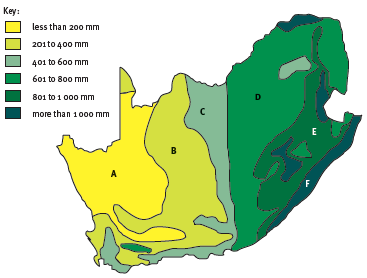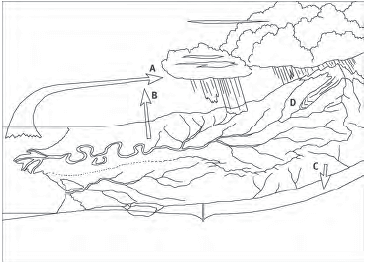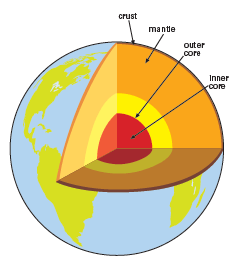Final Examination Revision Papers - Agricultural Sciences Grade 10 Study Guide
Share via Whatsapp Join our WhatsApp Group Join our Telegram GroupPaper 1
TIME: 2 HOURS
SECTION A
QUESTION 1
1.1 Various options have been given as answers to the following questions. Choose the correct answer and write only the letter (A – D) next to the question number in the ANSWER BOOK.
1.1.1 Hot deserts are regions where evaporation of water is the rainfall.
- lower than
- higher than
- similar to
- double.
1.1.2 Animals living in the grass tundra have adapted to the very cold conditions in a variety of ways. Indicate which of the adaptations below would be the most effective adaptation:
- A thick layer of fat below the skin
- Growth of dark coloured fur / pelts
- Thin pelts to help regulate body temperature
- Eating large volumes of food.
1.1.3 Typical savannah vegetation is
- proteas.
- short grass with shrubs
- tall grass with small deciduous trees.
- indigenous forests.
1.1.4 The practice of keeping/breeding animals under natural conditions in a certain ecological environment, is called production.
- natural livestock
- intensive livestock
- cattle
- extensive livestock
1.1.5 A cattle breed that has a thick hide that makes it difficult for lice or ticks to penetrate the skin is the
- Afrikaner.
- Hereford.
- Drakensberger.
- Jersey.
1.1.6 Reasons for the development of new breeds and plant cultivars:
- Adaptation
- Higher production
- Better quality
- All the above-mentioned
1.1.7 An example of a plant that can survive in dry/arid environmental conditions and which is mostly found growing on northern slopes, is called a/an
- sciophyte.
- xerophyte.
- hidrophyte.
- epihypte.
1.1.8 A dormant stage of animals in winter months is called
- estivation.
- hibernation.
- precipitation.
- astrophication.
(8 x 2) (16)
1.2 Give ONE-word answers for each of the statements or explanations below:
1.2.1 A farmer that grows just enough food for the family to live on
1.2.2 The practice of growing the same crop in the same soil continuously
1.2.3 A plant family that fixes nitrogen in the soil
1.2.4 Returning plant residues to soil to provide nutrients
1.2.5 The cattle breed that adapted to the African continent over the centuries
1.2.6 The practice where different breeds are interbred to develop a new breed
1.2.7 The increase of a country’s population that results in the need for greater food production
1.2.8 The dairy breed that produces the highest butter fat in milk
(8)
1.3 Choose an item/word from COLUMN B that matches the description/item/word in COLUMN A.
COLUMN A | COLUMN B |
1.3.1 Natural resources 1.3.2 Subtropical fruits 1.3.3 Symbiosis |
|
(3 x 2) (6)
1.4 Each of the following sentences consists of TWO statements. Choose the correct statement as follows:
- If the 1st statement is TRUE write A
- If the 2nd statement is TRUE write B
- If both statements are TRUE write C
1.4.1 | Government plays an important role in developing links with other countries | because | it negotiates trade agreements to ensure good markets for businesses. |
1.4.2 | An ant and plant lice are examples of mutualism | because | in mutualism one individual derives benefit and the other not. |
1.4.3 | People can produce food for themselves | because | they are directly dependent on agricultural activities for their food. |
1.4.4 | Lucerne is not capable of binding nitrogen | because | it contains no nitrogen fixing bacteria. |
(5 x 2) (10)
TOTAL SECTION A: 40
SECTION B
QUESTION 2
2.1 Study the distribution of rainfall in South Africa as shown in the map and key that accompanies the map.
2.1.1 Indicate what regions (A to F) would be more likely to have these individual rainfall figures. (Write down the LETTERS with the appropriate rainfall figures in the answer book.) (6)
2.1.2 Identify the region as indicated below.
- Region D
- Region B (2)
2.1.3 In which region would one find:
- Succulent plants
- Subtropical rainforests (2)
2.2
2.2.1 Explain what the difference is between the following:
- Sour veld
- Sweet veld. (2 x 2) (4)
2.2.2 Name the TWO abiotic factors that determine the type of veld found in the different ecological regions of South Africa. (2)
2.3 Read the following paragraph and answer the questions that follow:
The San People
The San are the oldest inhabitants of Southern Africa. They are a group of about 100 000 people who know a lot about the plant and animal life of the Kalahari and have learnt how to survive in this harsh environment. They are hunter-gatherers by tradition and have
excellent animal tracking and hunting skills. Many of them have been forced off their lands to live in settlement areas where they are unable to hunt or gather food.
The San discovered that the Hoodia succulent cactus plant prevented them from getting hungry and thirsty – very useful when on long hunting journeys. Their indigenous knowledge is now being used to produce a drug for dieting. The San people are very poor and would like to be paid by the drug companies that are using their knowledge.
2.3.1 Name THREE systems of farming used in South Africa today. (3)
2.3.2 The San migrated to gather food. What sort of food did they eat traditionally? (2)
2.3.3 Why do you think did the San people lose their habitat? (1)
2.3.4 What Act did the government put in place to redress the imbalances of land ownership of the past? (1)
2.3.5 Give TWO reasons for modern day migration, away from rural areas. (2)
2.3.6 The San’s indigenous knowledge is being put to use by producing a secondary industrial product. Name this product. (2)
2.4 Developing secondary industries is a natural process in meeting the demand of communities. Indicate what raw materials were used to produce the following products:
2.4.1 Wine
2.4.2 School shirts
2.4.3 Bacon
2.4.4 Bread (4)
2.5 During each wet or dry cycle that occurs every seven to nine years, South Africa received an above or below average rainfall just as was experienced in Mozambique a few years ago. These weather phenomena have a devastating effect on agricultural production. Name and give the reasons for each of these weather phenomena:
2.5.1 The dry period in a wet cycle
2.5.2 The above average rainfall or even floods (2 x 2) (4)
[35]
QUESTION 3
3.1 Study the water cycle illustrated below and answer the questions that follow:
3.1.1 What is indicated by the letters A to D. (4)
3.1.2 Indicate ONE method how the water loss as indicated by A to D, can be minimised. (4)
3.2
3.2.1 Why is the building of dams advantageous for agricultural production? Also state TWO negative effects of dams being build for water storage. (2)
3.2.2 What do we call the artificial application of water? (1)
3.3 Give the meaning of the following:
3.3.1 Herbivore
3.3.2 Carnivore (2 x2) (4)
QUESTION 3
4.1 Indicate which of the livestock is best suited to produce the following products:
| Dorper, Jersey, Australop, Dormer, Merino, Drakensberger, Angora,Dorper, Jersey,Australop, Dormer, Merino, Drakensberger, Angora,Large White, Frieslander, Simmentaler, Leghorn, Saannen |
4.1.1 Red meat production
4.1.2 Milk production
4.1.3 Wool production
4.1.4 Egg production
4.1.5 Meat and egg production
4.1.6 Mohair production
4.1.7 Meat and milk production
4.1.8 Meat and wool production
4.1.9 Goats milk production
4.1.10 Pork production (10)
[25]
TOTAL SECTION B: 60
Paper 2
TIME: 11⁄2 HOURS
SECTION A
QUESTION 1
1.1 Various options have been given as answers to the following questions. Choose the correct answer and write only the letter (A – D) next to the question number in the ANSWER BOOK.
1.1.1 The soil forming mineral that is a clear crystal, very hard, transparent to milky white and does not weather is
- biotite.
- quartz.
- augite.
- calcite.
1.1.2 The soil-forming mineral that weathers to form soils rich in phosphates is
- apatite.
- quartz.
- agite.
- calcite.
1.1.3 In the prevention of pollution it is important that the pesticides used for agricultural purposes must
- be biodegradable.
- have after effects.
- not be biodegradable.
- disrupt the food chain.
1.1.4 An example of physical weathering is
- running water.
- wind.
- carbonic acid.
- temperature changes.
1.1.5 The indigenous management of fungal diseases and insects was done by
- using onion and garlic extracts.
- using chemical insecticides.
- using DDT.
- removing weeds between the crops planted.
1.1.6 Which mineral is an example of a toxic ion in irrigation water?
- Boron
- Iron
- Calcium
- Magnesium Agricultural Sciences
1.1.7 An example of the plant family Graminaceae is
- wheat
- beans
- groundnuts
- soya beans
1.1.8 Veld management systems must be based on the principle of
- zero grazing.
- severe grazing.
- rotational grazing.
- selective grazing (8 x 2) (16)
1.2 Give ONE word answers for each of the statements below:
1.2.1 The practice where crops are planted without disturbing the soil
1.2.2 The practice where only one crop is grown over and over on the same land
1.2.3 The practice where plant residues are returned to the soil to provide nutrients
1.2.4 The farming method where a farmer grows just enough food for the family
1.2.5 The farming method where a farmer produces on a large scale for profit
1.2.6 The family that legumes belong to
1.2.7 The process refers to organisms changing organic material into humus
1.2.8 The process when minerals in rocks come into contact with oxygen (8)
1.3 Study the different types of crops in COLUMN B and match them with the information provided in COLUMN A. (6)
COLUMN A | COLUMN B |
1.3.1 Oil seeds | A kikuyu |
1.3.2 Field crops | B tobacco |
1.3.3 Horticultural crops | C deciduous fruits |
D sunflowers |
1.4 Draw a rough map of South Africa. On it, show where the horticultural crops in the list below that grow well.
1.4.1 Wine grapes
1.4.2 Citrus
1.4.3 Bananas
1.4.4 Cherries
1.4.5 Apricots (5)
TOTAL SECTION A: 35
SECTION B
QUESTION 2
2.1 Study the diagram showing the different layers of the earth and answer the questions that follow:
2.1.1 In which layer do we find magma? (1)
2.1.2 Define the term magma. (2)
2.1.3 Briefly describe the economic importance of the crust. (2)
2.1.4 Define igneous rocks and give an example of each and where they are formed. (5)
2.1.5 What do we call the continuous process of solid rock breaking down to form soil particles? (2)
2.2
2.2.1 Describe the term bare cultivation. (3)
2.2.2 Give FIVE disadvantages of this method of cultivation. (5)
2.2.3 What farming practice would you use to prevent erosion on the slopes? Give a reason for your answer. (2)
2.2.4 Explain the process of weathering. (3)
[25]
QUESTION 3
3.1
3.1.1 Describe step by step how you would go about laying out a compost heap. (6)
3.1.2 How would you go about testing the compost heap to see whether decomposition is actively taking place? (2)
3.1.3 Name FIVE benefits that compost will have for your soil. (5)
3. 2 Cultivated pasture plays a very important role in a sustainable supply of food. Briefly discuss this statement. (4)
3.3 Read the stories about the soil utilisation taking place on two different family farms.
The Mbuza family farm
Every member of the family helps on the farm. Lindiwe helps her grandma collect eggs and feed the chickens. She also helps to hoe the soil and dig in chicken manure. Bongani helps to milk the cows and move them from one pasture to another.
Vegetables also grow well. They make sure never to plant the same vegetables in the same soil two years in a row. ‘The vegetables all need different things from the soil,’ they say, ‘so if we do not plant the same things in the same soil, we give the soil a chance to re- build itself.’
The Mbuza pastures have good grass and the animals are fat. The animals are moved to different pastures to prevent the animals from eating all the grass. ‘The soil gets dry and blows away in the wind because there are no roots to keep it in place,’ says Mr Mbuza. Bongani helps his father to make fences between the pastures
The Nkondo family farm
They live near the Mbuza family. Although they have more cows and goats than the Mbuza family, they have not built fences around different pastures, so the animals graze all over the farm all the time.
The family used to grow vegetables but now they only grow mealies. ‘We bought a small tractor with the money that we get from selling our mealies,’ says Mrs Nkondo, ‘but I don’t think it is so good for the soil because it squashes the soil and only breaks it into big lumps.’
Lately the mealie production on the Nkondo farm has not been so good. The soil is dry and blows away in the wind.
3.3.1 Describe TWO methods used by the Mbuza family to keep their pastures and animals growing well. (2 x 2) (4)
3.3.2 List THREE reasons why the Nkondo family’s mealies are not growing well. (3)
3.3.3 Explain why the Nkondo animals are in poor condition. (2)
TOTAL SECTION B: 25
Memorandum: Paper 1
Question 1.1
1.1.1 B
1.1.2 B
1.2.3 D
1.1.4 D
1.1.5 C
1.1.6 A
1.1.7 B
1.1.8 C
Question 1.2
1.2.1 Subsistence
1.2.2 Monoculture
1.2.3 Legume
1.2.4 Zero tillage
1.2.5 Nguni
1.2.6 Crossbreeding
1.2.7 Population growth rate
1.2.8 Jersey
Question 1.3
1.3.1 A
1.3.2 E
1.3.3 F
Question 1.4
1.4.1 C
1.4.2 A
1.4.3 A
1.4.1 B
Question 2.1
2.1.1 A = less than 200 mm; B = 201 – 400 mm; C = 401 – 600 mm; D = 601–800 mm; E = 801– 1 000 mm; F = more than 1 000 mm
2.1.2
- D = Parts North West; Limpopo, Gauteng;
- B = Parts of Northern Cape, Western Cape and Eastern Cape
2.1.3
- A;
- F
Question 2.2
2.2.1
- Sour veld = Sour veld develops in areas with high rainfall more than 650mm; low rainfall with cold winter areas;
- Sweet veld = Sweet veld found in areas with low rainfall areas, 250–500 mm; high temperatures almost no frost
2.2.2 Adaptation of grasses to rainfall and the temperature, will determine the veld types
Question 2.3
2.3.1 Subsistence; small-scale; commercial
2.3.2 Game; certain roots and leaves
2.3.3 They were forced off their land by economic development: mining and agriculture
2.3.4 Restitution Act of 1994
2.3.5 People look for work and for a better life (education, medical care, etc.)
2.3.6 Hoodia succulent cactus plant
Question 2.4
2.4.1 Grapes
2.4.2 Cotton
2.4.3 Pork (pigs)
2.4.4 Wheat
Question 2.5
2.5.1 El Niño – temperatures over equatorial Pacific become warmer = more precipitation
2.5.2 La Niña – temperatures over equatorial Pacific become cooler = less precipitation
Question 3.1
3.1.1 A = Ocean evaporation; B = Land evaporation/transpiration; C = Percolation; D = Runoff
3.1.2 Mulching (prevent evaporation); contour ploughing (minimise runoff)
Question 3.2
3.2.1 Stores water for when it needed; makes water available where needed. Alters river courses; displaces people; causes siltation; can cause flooding
3.2.2 Irrigation
Question 3.3
3.3.1 Plant eating
3.3.2 Meat eating
Question 4.1
4.1.1 Drakensberger
4.1.2 Jersey; Frieslander
4.1.3 Merino
4.1.4 Leghorn
4.1.5 Australop
4.1.6 Angora
4.1.7 Simmentaler
4.1.8 Dormer
4.1.9 Saannen
4.1.10 Large White
Memorandum: Paper 2
Question 1.1
1.1.1 B
1.1.2 C
1.1.3 A
1.1.4 C
1.1.5 A
1.1.6 A
1.1.7 A
1.1.8 D
Question 1.2
1.2.1 Minimum cultivation / no-till
1.2.2 Mono culture / mono cropping
1.2.3 Mulching
1.2.4 Subsistence farming
1.2.5 Cash-crop farming
1.2.6 Leguminaceae
1.2.7 Humification
1.2.8 Oxidation
Question 1.3
1.3.1 D
1.3.2 B
1.3.3 C
Question 1.4
1.4.1 Western Cape
1.4.2 Eastern Cape (and around Citrusdal in Western Cape)
1.4.3 KwaZulu-Natal
1.4.4 Southeastern Free State
1.4.5 Boland
Question 2.1
2.1.1 Inner core
2.1.2 Melted rock / cooled down gas
2.1.3 Soil is formed in the crust where agricultural production takes place
2.1.4 Igneous rocks form due to cooling down of magna Granite – very deep cooling down slowly
Dolorite/ gabbro / basalt – shallow with a fine structure
2.1.5 Weathering
Question 2.2
2.2.1 A practice where all the plants are removed from the soil
2.2.2 Destroys structure and therefore weakens aeration; weakens water infiltration; weakens water capacity; hampers root penetration; difficult to till
2.2.3 Contour ploughing – the contours prevent runoff which prevents soil being washed away
2.2.4 When rocks are subjected to soil forming factors, such as weathering, over a period, the outer layer of the rocks loosens and crumbles to form soils. Rock weathering takes place through mechanical weathering, chemical weathering and biological weathering.
Question 3.1
3.1.1 Base – maize stalks; organic material, e.g. grass and leaves; manure; wood ash; lime; topsoil; dry leaves; water
3.1.2 Wire pushed into centre of compost heap – warm when taken out after 24 hrs / Open slightly – warm centre / Push hand in – warm inside
3.1.3 Improved structure; improved aeration; improved inflitration; improved water capacity; easier tillage; better root penetration
Question 3.2
Dung of cattle will fertilize the soil and:
- the urine will provide moisture and helps to form humus.
- After removing the cattle, the dung must be dug into the soil immediately to provide organic matter.
Question 3.3
3.3.1 Rotational grazing – camps rest to recover; Crop rotation – soil minerals replenished
3.3.2 Overgrazing – no rotation of grazing in camps; Over tiling – soil structure broken down; Mono crop cultivation – soil not being replenished
3.3.3 Over populated – carrying capacity of veld exceeded (should lessen animal numbers and practise rotational grazing)